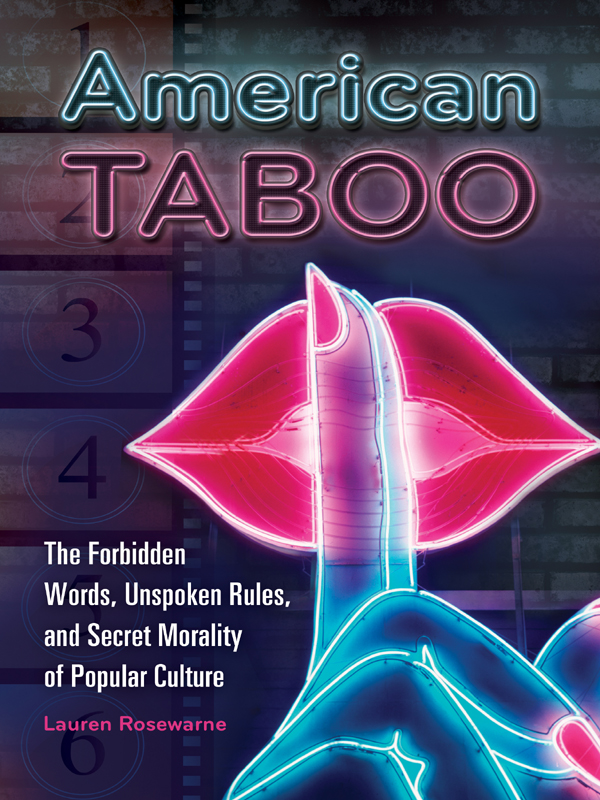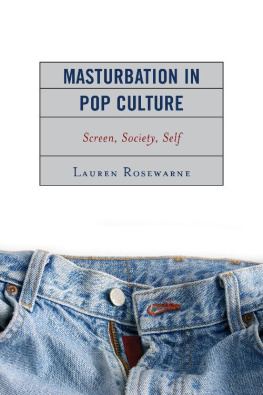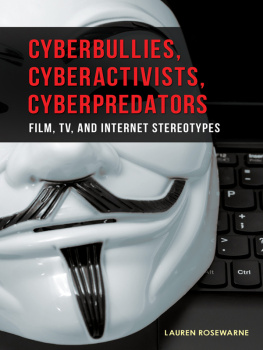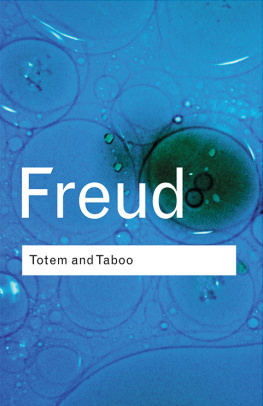
American Taboo
The Forbidden Words, Unspoken Rules, and
Secret Morality of Popular Culture
LAUREN ROSEWARNE

AN IMPRINT OF ABC-CLIO, LLC
Santa Barbara, California Denver, Colorado Oxford, England
Copyright 2013 by Lauren Rosewarne
All rights reserved. No part of this publication may be reproduced, stored in a retrieval system, or transmitted, in any form or by any means, electronic, mechanical, photocopying, recording, or otherwise, except for the inclusion of brief quotations in a review, without prior permission in writing from the publisher.
Library of Congress Cataloging-in-Publication Data
Rosewarne, Lauren.
American taboo : the forbidden words, unspoken rules, and secret morality of popular culture / Lauren Rosewarne.
pages cm
Includes bibliographical references and index.
ISBN 9780313399336 (cloth : alk. paper) ISBN 9780313399343 (ebook) 1. Sex in popular cultureUnited States. 2. SexSocial aspectsUnited States. 3. Popular cultureMoral and ethical aspectsUnited States. I. Title.
HQ16.R667 2013
306.70973dc23 2013011452
ISBN: 9780313399336
EISBN: 9780313399343
17 16 15 14 13 1 2 3 4 5
This book is also available on the World Wide Web as an eBook.
Visit www.abc-clio.com for details.
Praeger
An Imprint of ABC-CLIO, LLC
ABC-CLIO, LLC
130 Cremona Drive, P.O. Box 1911
Santa Barbara, California 93116-1911
This book is printed on acid-free paper 
Manufactured in the United States of America
Contents
Acknowledgments
With thanks to Daniel Harmon and James Sherman at ABC-CLIO. Thanks to my dear friends Bec Jackson and Melissa Donchi for many good conversations on the topics inside And Simon
Introduction: The Where and Why of Pop Cultures Hottest Buttons
Sex, politics, and religion. Three topics routinely considered off-limits in polite companyin mixed company; in refined company. Three subjects deemed personal, inflammatory, and best avoided out of respect, consideration, and diplomacy.
Historically, when popular culture dared present sex, politics, or religion explicitlyor even just franklyit was met with the wrath of censors, if not also rejection by audiences and advertisers. It is sex, politics, and religion that remain the perpetual hot buttonthe proverbial lightning rodtopics that even today in a post-Hays Code, tech-savvy, cable television mediascape consistently attract controversy and condemnation, bans and boycotts.
As a political scientist, as a feminist, without discussing sex or politics Id have very little to publish and certainly much less to talk about. Equally, while religion is generally not at the forefront of my work, there are some topics inextricably bound to all three lightning rods: abortion, homosexuality, masturbation, and circumcision are four discussed in this volume.
While sex, politics, and religion might be conversation topics that make first dates awkward, dinner parties uncomfortable, and classroom, staff-room, and locker-room discussions fiery, the very fact that they summon such strongsuch visceralreactions highlights that these are also the very topics that we have the most passion for and certainly harbor the most curiosity about.
In this book, Ive chosen to focus on some of my favorite taboos. From vibrators to cunnilingus, homosexuality to prescription drugs, naughty hand gestures to farting, these topics are all gloriouslyand variouslydivisive. Time and time again, these topics have been shown to titillate, offend, arouse, and create angstif not outrage. Likewise, each has a history of controversy and scandal, be it related to censorship, restricted classification, protest, or just accusations of poor taste.
While Ive titled this book American Taboo, the taboo topics analyzed in this volume arent actually taboo enough to remain completely unspoken. In fact, while these topics consistently attract controversy, such depictionsbe they flagrant displays or subtle allusionsare readily detected. Culturally, we might not like talking about vibrator use, but as explored in my Vibrator Chapter, screen scenes involving them are easily detected. Similarly, full frontal male nudity might be much less common than strategically concealed genitals, and yet my Penis Chapter includes more than 50 examples of penis displays from mainstream film and television. This trend occurs in every chapter whereby in real life discomfort haunts the discussion of a taboo, yet each has a distinct place in popular culture.
That presentations of taboos are easily detected highlights an interesting paradox. Evidently there are many subjects that remain difficult to talk aboutif not thoroughly polarizingin real life, yet each has a noticeable presence in popular culture. What does this strange situation reveal? Why are we so drawn to consuming portrayals of these controversial topics? Why do these subjects so heatedly divide in real life and yet are so fervently consumed through entertainment media?
As discussed in this Introduction and expanded upon throughout this volume, the manner in which controversial subjects are portrayed is not homogenous, nor is it easily understood. Off screen, anxieties are intimately entangled with these taboo topics and as many representations testify, anxieties often influence depictions. This, however, is not always the case: screen presentations are every bit as diverse as our opinions. While real-life portrayals often reflect cultural anxieties, they also function in a variety of other ways. Popular culture provides an opportunity for taboos to be tested and challenged, and for boundaries to be crossed and fears assuaged. While my Abortion Chapter, for example, explores narratives such as If These Walls Could Talk (1996) and Revolutionary Road (2008)where women were, ostensibly, executed following their abortionsin other films, such as Fast Times at Ridgemont High (1982) and Coach Carter (2005), womendaringlyaborted their pregnancies without any obvious punishment or guilt. Such diverse presentations are analyzed to explore what they reveal about society as well as the sexual and cultural politics inherent.
Worth noting, popular culture also provides audiences with a unique opportunity to simply experience taboos: to be involved with them vicariously, to hear about them, to be aroused by them, and to have our curiosity about them quenched.
American Taboo focuses on taboos primarily associated with the body: how we use our bodies (see the Farting Chapter and the Rude Gestures Chapter), expose our bodies (see the Penis Chapter), what we put into them (see the Drugs Chapter, the Vegetarian Chapter, and the Alcohol Chapter), do to them (see the Abortion Chapter and the Circumcision Chapter), and how we give and draw pleasure from them (see the Vibrator Chapter, the Oral Sex Chapter, and the Gay Chapter). Each of these chapters explores those many occasions when popular culture dares to tempt the wrath of audiences, advertisers, and censors by grappling with societys most challenging topics.
The hundreds of popular culture examples discussed in this volume are analyzed to explore the how and why of their depiction as well as the what that they reveal about society, about media production, and notably about our continually complicated relationship with our bodies. This volume draws on a very wide range of disciplines to do this, including cultural studies and queer theory, psychology, political science, feminist theory, and sociology. Identifiable in each chapter are some important findings. Rarely, for example, are taboo topics presented as
Next page










